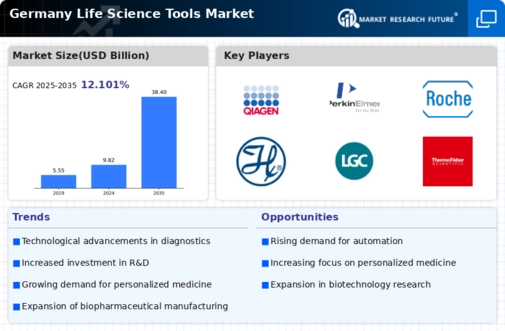Emphasis on Sustainable Practices
Sustainability is becoming an increasingly important consideration within the life science tools market. As environmental concerns gain prominence, companies are being urged to adopt sustainable practices in their operations. This shift is likely to influence the design and production of life science tools, with an emphasis on reducing waste and utilizing eco-friendly materials. The market is expected to see a rise in demand for tools that not only meet scientific needs but also align with sustainability goals. In 2025, it is estimated that around 30% of life science tools will incorporate sustainable features, reflecting a growing commitment to environmental responsibility. This trend may also drive innovation as companies seek to differentiate themselves in a competitive landscape by offering sustainable solutions. Consequently, the life science-tools market is poised for transformation as sustainability becomes a core value in product development.
Expansion of Biopharmaceutical Sector
The biopharmaceutical sector in Germany is experiencing robust growth, which is significantly impacting the life science-tools market. With an increasing number of biopharmaceutical companies emerging, the demand for specialized tools and technologies is on the rise. In 2025, the biopharmaceutical market is projected to reach €50 billion, driven by advancements in biologics and biosimilars. This expansion is likely to create opportunities for life science tool manufacturers to develop products that cater specifically to the needs of biopharmaceutical research and production. Additionally, the focus on biologics is expected to drive innovation in analytical tools, quality control systems, and production technologies. As the biopharmaceutical sector continues to evolve, the life science-tools market is anticipated to benefit from the growing need for advanced solutions that support drug development and manufacturing processes.
Growing Demand for Personalized Medicine
The life science-tools market is witnessing a significant shift towards personalized medicine, which is reshaping the landscape of healthcare in Germany. This approach tailors medical treatment to individual characteristics, needs, and preferences, thereby enhancing patient outcomes. The market for personalized medicine is anticipated to grow at a CAGR of 8% through 2025, driven by advancements in genomics and biotechnology. As healthcare providers increasingly adopt personalized treatment plans, the demand for specialized life science tools that facilitate genetic testing and biomarker analysis is likely to rise. This trend not only reflects a broader movement towards precision medicine but also indicates a growing recognition of the importance of individualized care in improving therapeutic efficacy. Consequently, the life science-tools market is expected to expand as companies develop innovative solutions to meet this evolving demand.
Increased Focus on Automation and Efficiency
Automation is becoming a pivotal driver in the life science-tools market, particularly in Germany, where laboratories are increasingly adopting automated systems to enhance efficiency and productivity. The integration of automation technologies is expected to reduce operational costs by up to 20%, allowing laboratories to allocate resources more effectively. This trend is indicative of a broader movement towards streamlining workflows and minimizing human error in laboratory settings. As a result, the demand for automated life science tools, such as robotic systems and high-throughput screening technologies, is likely to rise. Furthermore, the push for efficiency aligns with the growing emphasis on data accuracy and reproducibility in scientific research. Consequently, the life science-tools market is poised for growth as companies innovate to provide solutions that meet the needs of modern laboratories.
Rising Investment in Research and Development
The life science tools market is experiencing a notable surge in investment directed towards research and development (R&D). This trend is primarily driven by the increasing demand for innovative solutions in healthcare and biotechnology. In 2025, R&D spending in the life sciences sector is projected to reach approximately €10 billion, reflecting a growth rate of around 5% annually. This influx of capital is likely to enhance the development of advanced tools and technologies, thereby fostering innovation within the industry. Furthermore, the German government has been actively promoting initiatives to support R&D, which may further stimulate growth in the life science-tools market. As a result, companies are expected to invest heavily in developing cutting-edge tools that can address complex biological challenges, ultimately driving market expansion.




















Leave a Comment